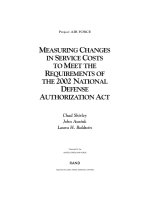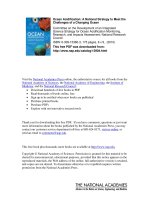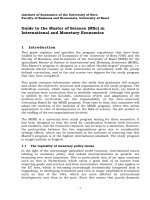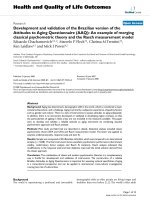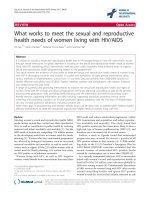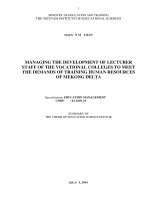Designing eLearning courses to meet the digital literacy needs of healthcare workers in lower- and middle-income countries: Experiences from the Knowledge for Health Project
Bạn đang xem bản rút gọn của tài liệu. Xem và tải ngay bản đầy đủ của tài liệu tại đây (301.12 KB, 16 trang )
Knowledge Management & E-Learning, Vol.7, No.4. Dec 2015
Knowledge Management & E-Learning
ISSN 2073-7904
Designing eLearning courses to meet the digital literacy
needs of healthcare workers in lower- and middle-income
countries: Experiences from the Knowledge for Health
Project
Rupali J. Limaye
Sidhartha Deka
Naheed Ahmed
Lisa Mwaikambo
Johns Hopkins University, Baltimore, USA
Recommended citation:
Limaye, R. J., Deka, S., Ahmed, N., & Mwaikambo, L. (2015). Designing
eLearning courses to meet the digital literacy needs of healthcare workers
in lower- and middle-income countries: Experiences from the Knowledge
for Health Project. Knowledge Management & E-Learning, 7(4), 601–615.
Knowledge Management & E-Learning, 7(4), 601–615
Designing eLearning courses to meet the digital literacy
needs of healthcare workers in lower- and middle-income
countries: Experiences from the Knowledge for Health
Project
Rupali J. Limaye*
Center for Communication Programs
Johns Hopkins Bloomberg School of Public Health
Johns Hopkins University, Baltimore, USA
E-mail:
Sidhartha Deka
Center for Communication Programs
Johns Hopkins Bloomberg School of Public Health
Johns Hopkins University, Baltimore, USA
E-mail:
Naheed Ahmed
Center for Communication Programs
Johns Hopkins Bloomberg School of Public Health
Johns Hopkins University, Baltimore, USA
E-mail:
Lisa Mwaikambo
Center for Communication Programs
Johns Hopkins Bloomberg School of Public Health
Johns Hopkins University, Baltimore, USA
E-mail:
*Corresponding author
Abstract: Traditional conceptualizations of knowledge management fail to
incorporate the social aspects in which knowledge management work operates.
Social knowledge management places people at the center of all knowledge
management, including placing the end user at the center when developing
eLearning packages, particularly within the context of digital health literacy. As
many health professionals working in lower-resource settings face the digital
divide, or experience unequal patterns of access and usage capabilities from
computer-based information and communication technologies (ICTs), ensuring
that eLearning packages are tailored for their specific needs is critical.
Grounded in our conceptualization of social knowledge management, we
outline two of our experiences with developing eLearning packages for health
professionals working primarily in lower- and middle-income countries. The
602
R. J. Limaye et al. (2015)
Global Health eLearning Center provides eLearning courses to health
professionals primarily working in the lower- and middle-income country
context. The courses have robust and exhaustive mechanisms in place to ensure
that issues related to digital health literacy are not barriers to taking the courses
and subsequently, applying the course material in practice. In Bangladesh, we
developed a digital health package for frontline community fieldworkers that
was loaded on netbook computers. To develop this package, community
fieldworkers were provided support during the implementation phase to ensure
that they were able to use the netbooks correctly with their clients. As new
digital technologies proliferate, guaranteeing that global health workers have
the prerequisite skills to utilize and apply digital health tools is essential for
improving health care.
Keywords: Social knowledge management; Developing
Participatory development; Global health; Digital literacy
countries;
Biographical notes: Dr. Rupali J. Limaye is a social and behavioral scientist.
In her 10 years of working in global health, she has worked in Ethiopia, Haiti,
India, Kenya, Lesotho, Malawi, Nigeria, South Africa, Tanzania, and Uganda,
on topics including family planning, HIV prevention, care and treatment,
maternal and child health, and alcohol. She has been published in international
peer-reviewed journals and is associate faculty at the Johns Hopkins
Bloomberg School of Public Health, where she teaches graduate classes in
behavior change theory and social marketing. Rupali holds a doctoral degree in
social and behavioral sciences from the Johns Hopkins Bloomberg School of
Public Health and a Master of Public Health and Master of International Affairs
from the George Washington University.
Sidhartha Deka is a knowledge management and improvement science
specialist for the USAID-funded Applying Science to Strengthen and Improve
Systems Project, which seeks to improve health care in low-resource settings in
16 countries. Previously, he worked as a technical advisor for family planning
in the Bangladesh Ministry of Health and Family Welfare as a part of the
USAID Knowledge for Health Project implemented by the Johns Hopkins
Center for Communication Programs. Sidhartha holds a Master of Science in
Public Health from the Johns Hopkins Bloomberg School of Public Health.
Naheed Ahmed has worked for the Johns Hopkins Center for Communication
Programs since 2012. As a Monitoring & Evaluation Program Officer in the
Knowledge Management Unit, she assists with KM research activities, such as
needs assessments, routine monitoring, and impact evaluations. She is
experienced in qualitative and ethnographic field research, and has an interest
in using data visualization to communicate research findings. Naheed holds a
Master of Public Health and Master of Bio-cultural Medical Anthropology
from the University of South Florida.
Lisa Mwaikambo (née Basalla) has worked for the Johns Hopkins Center for
Communication Programs since 2007. She has served as a co-manager of the
USAID Global Health eLearning (GHeL) Center. In her role on GHeL, Lisa
managed the $1.5 million President's Emergency Plan for AIDS Relief online
distance learning and training program in strategic information. Her experience
spans knowledge management, instructional design and online facilitation,
program design, and implementation, and management, and research and
evaluation. Lisa has extensive experience in family planning and HIV. She is a
certified Knowledge Manager and has a Master of Public Health from Case
Western Reserve University.
Knowledge Management & E-Learning, 7(4), 601–615
603
1. Introduction
Knowledge management has been defined in many ways, but perhaps the simplest way to
describe it is the process of capturing, distributing, and effectively using knowledge
(Davenport, 1994). However, we argue that current conceptualizations of knowledge
management fail to recognize and incorporate human and organizational dynamics. We
view human and social factors as critical to effective knowledge management work, and
therefore suggest a conceptualization of social knowledge management which highlights
the “social” pillars of knowledge management: driven by social benefit, occurring within
social systems and social interaction, which includes social networks, social learning,
social capital, and social media (Fig. 1).
Fig. 1. Pillars of social KM
We suggest that these pillars should underlie and guide the traditional dimensions
of knowledge management, such as the processes to generate, capture, synthesize,
exchange and use knowledge; technology to support knowledge management
interventions; organizational systems to support a culture of knowledge management; and
key relationships that facilitate exchange and knowledge use. A critical aspect of this
conceptualization is that it is people-centric and structured in networks that promote twoway and many-to-many flows of knowledge (Table 1).
Given our conceptualization of knowledge management, which we call social
knowledge management, we approach the knowledge needs of our end users, primarily
community health workers, health providers, and program managers (which we
collectively refer to as health professionals in this manuscript) working in lower- and
middle-income countries, through this people-centric approach, and rely on them to
ensure that we develop and implement knowledge management approaches with their
digital literacy needs as a key factor. In this paper, we outline the importance and
information needs of health professionals within the context of global health, and discuss
604
R. J. Limaye et al. (2015)
how we utilized our social knowledge management approach to ensure that their digital
health literacy needs drove the development and implementation of eLearning activities
in two case studies housed within the Knowledge for Health (K4Health) Project.
Table 1
Comparison of knowledge management approaches
Traditional knowledge management
Social knowledge management
For competitive advantage
Driven by available technology
Structured in hierarchies
Relegates into “folders”
Top-down knowledge transfer
Closed, controlled &
proprietary
Knowledge for power
For social benefit
Driven by people and relationships
Structured in networks
Tags with keyword to enable
dynamic identities
Two-way, many-to-many flow
Free, fluid and open
Shared knowledge for impact
2. Information needs of health care providers within the global health
context
Community health workers, health providers, and program managers play a key role in
improving health outcomes in lower- and middle-income countries (World Health
Organization, 2006). As many lower- and middle-income countries rely on health care
workers to reach rural and remote areas, it is particularly troublesome that many face
staff shortages of health professionals within rural and remote areas (Lehmann, Dieleman,
& Martineau, 2008). Indeed, there is increasing concern about the scarcity of health
professionals to address pressing issues, like health equity, health disparities, and
infectious diseases (Chen et al., 2004; Pang, Lansang, & Haines, 2002). Health
professionals working at the community level play multiple roles, including patient and
community education, counseling, monitoring and tracking patients, and linking people
to care, among others (Brownstein et al., 2005). Evidence indicates that they are able to
improve health care access as well as outcomes and improve the quality of life in
underserved communities (Rosenthal et al., 2010).
However, health professionals in lower- and middle-income countries are in dire
need of life-saving information (Kale, 1994). Many have little to no access to basic,
practical information (Pakenham-Walsh, Priestley, & Smith, 1997; Macrorie, 1997;
Sekikawa, Laporte, Satoh, & Ochi, 1997) and some have come to rely on observation,
advice from colleagues, and experiential learning when caring for and treating patients
(Pakenham-Walsh & Bukachi, 2009). A literature review that examined the health
information needs of health professionals in lower-resource countries found that most
lacked knowledge about the basics regarding the diagnosis and management of common
diseases, resulting in suboptimal health care practice (Pakenham-Walsh & Bukachi,
2009). The provision of health information is essential to delivering quality health care,
as it is able to provide direction and a rationale for guiding treatment decisions (Kreps,
2000). Providing access to relevant and timely health information to health professionals
is potentially the single most cost-effective and feasible strategy for health care
Knowledge Management & E-Learning, 7(4), 601–615
605
improvement in lower- and middle-income countries (Pakenham-Walsh, Priestley, &
Smith, 1997).
3. Moving toward digital health within the global health context
The use of digital health tools can help address the global health professional worker
shortage and the lack of access to continuing professional development opportunities
(Aluttis, Bishaw, & Frank, 2014; Nartker et al., 2010). Defined in numerous ways, digital
health broadly encompasses the communication of health information through computer
technology and the Internet (Brodie et al., 2000) and is increasingly becoming a critical
tool in delivering effective global health programs specifically in lower- and middleincome countries, including capacity building assistance and training (Aluttis, Bishaw, &
Frank, 2014). The need for rapid access to information to support critical decisions in
public health is paramount (Revere et al., 2007).
Digital health is particularly relevant within a learning context and is a key aspect
of knowledge management. Many conventional training programs require that health
professionals leave their workplaces to participate in trainings, which, in turn, can cause
serious disruptions in service delivery and further exacerbate imbalances in health
workers’ knowledge and skills (Gaye & Nelson, 2009). As a result, global health program
designers are exploring novel ways to ensure that health professionals are provided with
access to high-quality formal and informal continuing professional development
opportunities when most convenient to them. eLearning has become a popular and more
readily accessible approach to building the capacity of health professionals with the
growth in mobile and Internet access and new information and communication
technologies (ICTs) for delivering training content (Bollinger et al., 2013). eLearning can
broadly be defined as the use of network technology to deliver training (Welsh, Wanberg,
Brown, & Simmering, 2003), and this approach to synthesizing and packaging
knowledge in an easily digestible way and transferring this knowledge so that it is
ultimately used is the essence of knowledge management (Davenport, De Long, & Beers,
1998). eLearning systems provide a flexible and sustainable way to provide continuous
learning yielding improvements in health worker knowledge and skills (George et al.,
2014). eLearning has been used in conjunction with other training approaches, known as
“blended learning,” in which a combination of a variety of learning media (face-to-face,
online, print, social media) and learning environments (instructor-led, teamwork, peer-topeer interaction, self-study and individual work), enables more opportunities for
application and support to learners than a one-off training event.
However, using digital health within a global health context comes with its own
set of challenges. Others have written about the ‘digital divide’, which refers to unequal
patterns of material access to, usage capabilities of, and benefits from computer-based
ICTs (Fuchs & Horak, 2008). While technologies can enable human practices, they can
concurrently constrain them. End users must possess the capability to use such digital
technologies, as well as the capability to use them in such ways that confer benefits, and a
key barrier, which has been identified within the lower-resource settings, is the lack of
digital skills and financial resources to support the use of digital technology (Van Dijk &
Hacker, 2003). However, eLearning is often viewed as a means to address the digital
divide between rural and urban settings by providing health professionals in rural settings
with opportunities to use digital health tools and access the same training content as their
peers in urban settings (Ruxwana, Herselman, & Conradie, 2010).
606
R. J. Limaye et al. (2015)
Additionally, the rapid development of digital technologies requires the end user
to possess a growing assortment of skills in order to utilize such technologies. These
skills are often referred to as “digital literacy” (Bulger, Mayer, & Metzger, 2014; Gilster
& Gilster, 1997; Inoue, Naito, & Koshizuka, 1997; Pool, 1997). There has been an
increased focus on literacy within digital approaches across various social contexts, in
response to globalization and the growing range of available technologies (Mills, 2010).
Despite its widespread popularity, there are many conceptualizations of digital and
eHealth literacy. Some suggest that digital or eHealth literacy refers to the ability to seek,
find, comprehend, and evaluate health information from digital resources and then apply
this information to solve a health problem (Norman & Skinner, 2006a; 2000b), while
others have a slightly different view, suggesting that digital literacy refers to possessing
capabilities beyond a simple competence in retrieving information from a digital
technology medium (Bawden & Robinson, 2002), and digital literate individuals should
be characterized as those that are able to acquire and use information appropriate for any
situation (Rader, 1991).
In addition to varying conceptualizations, there is a divide between what end users
can be expected to do and the demands for and availability of different digital resources.
A number of studies in educational media, health literacy, and numeracy have sought to
minimize this gap by addressing user knowledge and competence and improving
available resources. Addressing resource access as well as user skill levels has assisted in
the development of digital applications that are more likely to impact those with the most
pressing health issues (Eng et al., 1998).
4. Role of health literacy in uptake of materials designed for health care
providers
From a broader perspective, the concept of health literacy (from which digital literacy is
situated within) was developed primarily within a higher-income country and clinical
context, as a way to help physicians strengthen their communication with their patients,
characterizing health literacy as a patient problem that physicians were expected to
overcome (Pleasant & Kuruvilla, 2008). However, the conceptualization of health
literacy differs between a clinical context and public health context, as physicians focus
on obtaining information about and from a patient while public health practitioners focus
on delivering information such as knowledge on relevant health behaviors to specific
audiences. The public health approach to health literacy views the acquisition of
knowledge as an integral component of health literacy rather than as a separate outcome
(Nutbeam, 2000; St Leger, 2001; Zarcadoolas, Pleasant, & Greer, 2006).
The role of health literacy as an important factor influencing health outcomes has
been increasingly gaining attention, but while general health literacy is an important
determinant of health, it is not sufficient to address the major health challenges facing
lower- and middle-income countries (Kickbusch, 2001). Furthermore, most efforts related
to health literacy have focused on patients, and studies examining the needs of health
professionals are limited. A recent study suggests that there is a need to improve the
health literacy of health professionals at all levels within a health system, as this would
improve health care delivery to patients (Mackert, Ball, & Lopez, 2011). Relating back to
digital literacy, the health literacy literature suggests that there is also a need to examine
digital literacy through a public health context, with a focus on digital literacy of health
professionals at all levels within a particular health system.
Knowledge Management & E-Learning, 7(4), 601–615
607
5. People as drivers of their information needs, including mode of delivery
and format
While developing programs, it is common knowledge that including the end user in
program planning and application design could improve programming itself as well as
study evaluation design (Nichols, 2002). For example, understanding the motivations of a
particular target audience by involving them in the planning process can assist in the
development of a more targeted intervention for behavior change (Krasny & Doyle,
2002). From a research perspective, numerous communities have asked for programs to
take into account their perceptions, needs, and circumstances, and one way to assure this
participation is the employment of a participatory approach by engaging communities in
the formulation of research questions and interpretation of data (Green & Mercer, 2001).
Specific to the digital literacy context, several scholars recommend matching digital
health technologies to the skills of their intended users, due to the notion that such a fit
can also help improve users’ working knowledge of digital technologies to a level that is
supportive of achieving health-related goals (Norman & Skinner, 2006a; Norman &
Skinner, 2006b).
Another important debate regarding the use of digital technologies in lower- and
middle-income countries relates to content. As content for digital health technologies is
typically developed and produced by fluent English speakers with advanced degrees,
some wonder if the individuals accessing the content living in these lower- and middleincome countries will be passive consumers of this information, and how can the end
users serve as potential creators and contributors of the content (Alzouma, 2005).
Through our conceptualization of social knowledge management, we assert that
the end user of the intervention should drive the process for developing, implementing,
and adapting any knowledge management tool. We provide two case studies from the
K4Health Project, which seeks to improve health services in lower- and middle-income
countries by ensuring that knowledge gets into the hands of health professionals who
need it most. The case studies illustrate how we relied upon and worked hand-in-hand
with the end users of eLearning packages to ensure that these packages incorporated and
addressed factors related to digital health literacy.
6. Global Health eLearning Center
The Global Health eLearning Center (GHeL) was established in 2005 in response to
growing demand from United States Agency for International Development (USAID)
staff working in lower- and middle-income countries for global health technical updates.
Courses are proposed by subject matter experts from various implementing partner
organizations or by USAID staff who are technical experts. A team at USAID and
K4Health review the course proposal to see if it meets the needs of the GHeL audience
and would be an appropriate fit given the current offerings. Often times, courses are
proposed based on existing in-person training curricula or the newest programmatic
guidance issued by global technical organizations. These in-person trainings are
conducted in lower- and middle-income countries either by request of local health
institutions and organizations or based on needs identified by the implementing partner
organization. Since course authors are unable to conduct trainings everywhere, GHeL
courses provide a platform for meeting continuing professional development needs
globally, in particular for health generalists, who manage a broad range of health
programs.
608
R. J. Limaye et al. (2015)
When GHeL was first launched it was field tested in diverse settings around the
world, including South Africa, India, and the United States. Results from the field testing
confirmed the usability of the platform and validated the depth of knowledge and
materials covered in the courses. Although GHeL’s primary audience is USAID staff,
other health professionals were taking advantage of these free, self-paced, expertly vetted
courses even though they were not promoted widely. Doctors, nurses, technical advisors,
and students saw the courses as an opportunity to build their professional development,
and program managers saw them as a resource for training staff at their organizations.
There are currently more than 70 online courses on the GHeL platform, covering a range
of health topics, including family planning, HIV/AIDS, and maternal, neonatal, and child
health.
This large secondary audience of GHeL comprises about 85% of the 125,000+
registered users to the site. Given that this audience is more geographically dispersed in
lower- and middle-income countries, not just concentrated in urban centers, the GHeL
staff initiated new measures to meet the information and digital health literacy needs of
this global cadre of health professionals. In 2010-2011, the K4Health Project conducted
the first comprehensive evaluation of GHeL to determine its reach, use, and usefulness, to
improve collection and analysis of data, and to enhance the GHeL learning experience.
The evaluation included a literature review, expert interviews, and analysis of data from
October 2005 to April 2010; an online survey with course completers and non-completers;
and in-depth interviews. Evaluation findings largely confirmed that the learners are
satisfied, often completing numerous courses after completing the first course
(Mwaikambo, Avila, Mazursky, & Nallathambi, 2012). Many learners reported that the
courses serve as valuable sources of knowledge as well as critical source of updated
technical information. In addition, the evaluation indicated a demand to translate course
content into specific local languages.
The user feedback informed the GHeL redesign that was undertaken in 2013. As
learners indicated that access remained an issue, GHeL offered learners’ the ability to
download and save PDF versions of the courses as well as a print option for later study.
The GHeL team is currently pilot testing the translation of the platform and a limited
number of courses into Arabic, French, Portuguese, and Spanish and continues to work
with subject matter experts in developing content that is free of jargon, written according
to best practices in writing and reading for the Web, and is written in a manner that nonnative English speakers can easily understand.
Regarding digital literacy, detailed instructions and guidance on how to use
courses, download course content, and obtain course certificates are available on the
GHeL website under frequently asked questions (FAQs). In addition, GHeL staff created
a video tutorial on “Getting Started” that provides screenshots and instructions on how to
register and enroll in a course and familiarizes a learner to the basic navigation of a
course. Finally, learners can contact GHeL staff through the website contact page as well
as via email for individualized support.
GHeL courses are often used by health organizations in two main ways –
internally and externally. Internally, local health organizations use the courses to train
staff, since many organizations do not have the finances to fund ongoing training of staff.
A GHeL learner from Ghana who completed the IUD course shared that “Neonatal
deaths had been a big problem in my district and I needed the course to help train my
midwives and nurses in the ‘mother-baby-unit’ of the district hospital”. The courses help
health professionals around the world stay current on the latest developments in the
global health field. Externally, organizations use the GHeL courses as part of a blended
Knowledge Management & E-Learning, 7(4), 601–615
609
learning strategy to reinforce and complement their other training activities with their
target audience – often external to their specific organization. For example, a USAIDfunded initiative in Kigali, Rwanda requested that participants complete a GHeL course
prior to the face-to-face training workshop to ensure that all of the participants had at
minimum the same basic level of knowledge at the start of the workshop and to inform
the agenda of the workshop, since the facilitators were given the participants’ final exams
and could see which questions were most often answered incorrectly. In this way, the
facilitators could truly tailor the face-to-face training workshop to meet the needs of the
participants. As organizational and staff capacity in technical health areas increases, so
does the quality of health services, which leads to improved counseling and treatment of
clients (Pakenham-Walsh, Priestley, & Smith, 1997). Learners also build their digital
literacy skills, since the courses require successfully navigating web pages and using
interactive features, such as a new community feature that allows learners to
communicate with each other which was developed in response to learner feedback. The
digital skills acquired from the courses prepare learners to engage with the growing field
of online learning opportunities and connect with other health professionals through
online communities of practice.
The current platform is suited for mobile phones and Google Analytics reveal that
more than 15% of our site activity is from mobile devices. Given the exponential growth
in mobile technology, GHeL staff are exploring a number of content delivery methods to
reach health professionals at the community level who often work in rural settings and
have very limited access to the Internet as well as continuing professional development
opportunities. Currently, GHeL is evaluating three adaptation and delivery mechanisms
and a major component of these evaluations is to ensure that course content is delivered
in a format that matches the digital health literacy needs of the end user. These adaptation
models include: text and graphic deployed via a learning module on a mobile application,
quiz content deployed via audio through an interactive voice response system, and
translated text and graphic with the option of audio in the format of a game-like mobile
application. Through this process, GHeL is not only documenting the learning outcomes
of these efforts but also the process so that this can be shared with training organizations
in lower- and middle-income countries that may find these delivery methods more
appropriate for their target audiences.
7. Bangladesh Knowledge Management Initiative
The Bangladesh Knowledge Management Initiative (BKMI) was implemented by the
K4Health Project to facilitate a knowledge sharing culture within a lower-resource setting
among key stakeholders, including health care providers, health program managers, and
behavior change agents such as public sector frontline health workers - Family Welfare
Assistants (FWA) and Health Assistants (HA).
In order to improve the knowledge- and skill-based competencies of frontline
workers throughout Bangladesh in the areas of health, population, and nutrition; BKMI
piloted a foundational digital health platform of evidence-based best practices, standards,
and guidelines for basic communication and health interventions along with a
comprehensive set of behavior change communication (BCC) tools and resources. This
digital health platform included an eToolkit and eLearning courses.
This digital health platform was developed due to a number of challenges
frontline workers face when they counsel clients. Formative research indicated that these
workers had too many materials and job aids to carry; lacked basic knowledge, tools, and
610
R. J. Limaye et al. (2015)
training to effectively counsel and treat their clients; and possessed materials and job aids
that included inconsistent or contradictory messaging. Given these gaps, BKMI compiled
a “gold standard” of BCC resources to be part of an eToolkit along with integrating the
Government of Bangladesh’s (GOB) standards for counseling clients into an eLearning
curriculum. The resources were compiled in consultation with stakeholders such as GOB,
international health agencies, and local non-governmental organizations. These two
components of the digital health platform were subsequently deployed as part of an
eHealth pilot in two districts.
The digital health platform was developed for users with a high school
education—a standard at which GOB appoints frontline workers. A formative assessment
of frontline workers’ digital literacy was not done but all resources on the platform were
compiled and created in accordance with GOB’s standard for educational attainment, and
to ensure that usability of the platform catered to the existing digital literacy of frontline
workers, BKMI undertook a structured pretest interview with eight frontline health
workers before the eHealth pilot was rolled out. The interviews assessed general
computer literacy, the ability to register for and navigate the eToolkit and eLearning
courses, and the overall usability of both components. The pretest found that the frontline
workers were able to use the digital health platform but attested to discrepancies in the
local language instructions in the platform navigation. Based on the pretest results, the
platform developers made adjustments to the reading of the local language on the
platform.
In the course of three and a half months, BKMI piloted its digital health platform
with approximately 300 frontline health workers. These frontline workers received the
platform on netbook computers to supplement their knowledge and enhance their
counseling activities with clients. During the implementation phase, frontline workers
used the digital health platform during their normal counseling activities with clients in
villages. BKMI hired Monitoring and Troubleshooting Officers (MTOs) to visit frontline
workers every two weeks and troubleshoot any technology-related issues. The MTOs also
manually issued and collected eLearning course assessments to and from frontline
workers, in order to assess their progress through the courses. Finally, the MTOs
collected periodic “proficiency information” to assess the gradual increase in ability to
use and operate the netbook. Along with the biweekly MTO visits, the BKMI team
conducted three monthly monitoring visits to collect qualitative information through
focus group discussions and key informant interviews, which included assessments of
frontline workers’ attitudes and behaviors in their use of the digital health platform.
Results indicated that frontline workers enjoyed using the platform and found the
technology easy to use; frontline workers used the eLearning courses for counseling their
clients in addition to improving their subject area knowledge and skills; and the use of the
platform in their counseling increased their status within the community, resulting in
increased demand for more health advice from mothers.
A pre-assessment was conducted before the pilot began, and the same assessment
was conducted after the pilot was over. Both assessments collected information on
frontline workers’ knowledge and counseling skills. The post-assessment results
indicated substantial increases in frontline workers’ knowledge across intervention
subject areas – such as family planning and nutrition. For example, frontline workers’
knowledge regarding the available options for family planning increased approximately
30% from the pre-assessment to the post-assessment. Regarding nutrition, frontline
workers’ knowledge regarding the benefits of exclusive breastfeeding increased
approximately 10% from the pre-assessment to the post-assessment.
Knowledge Management & E-Learning, 7(4), 601–615
611
The success of BKMI’s digital health platform through field-testing demonstrates
that broadening access to health information through digital health applications can
improve health service delivery at the household level. Moreover, the planning and
development of the platform took into consideration the gaps in digital literacy that the
frontline worker may face in use of the platform, which was achieved through
consultation with local stakeholders and pretesting with frontline workers. Despite these
gains, factors such as government buy-in, cost-effectiveness of digital health applications,
and in-country capacity to operate these innovations will be important to determine the
scalability of the eToolkit and eLearning courses for use by all public sector frontline
workers.
8. Discussion
These two case studies illustrate two different experiences the K4Health Project had with
regard to developing and delivering eLearning in two contexts. The GHeL platform
demonstrated that continuing professional development can be delivered virtually to a
global audience of health professionals and that the information and general literacy as
well as specific digital literacy needs of these audiences can be met through careful
content curation to ensure understanding and application of knowledge. Reaching the end
beneficiary of health services, the BKMI digital health platform provides a streamlined
alternative to meet the needs of the clients of frontline health workers in Bangladesh. In
adopting educational technologies to build the competencies and skills of health workers,
other initiatives should consider utilizing a participatory process from the beginning –
one that involves not only technologists and subject areas experts but also the end users
who will use such applications to inform the development of the interface and structure of
such technologies.
Regarding the future use of digital health within the global health context, the
ability of digital health to transcend sociopolitical boundaries translates to the potential
increase in efficiency of health care delivery (Mars & Scott, 2010). Access to digital
health technologies continues to grow, and the gap between lower- and middle-income
countries and higher-income countries has been shrinking in terms of mobile subscribers,
fixed telephone lines, and Internet users, although disparities remain between rural and
urban areas (Kyem & LeMaire, 2006). Additionally, although there have been great
advancements with regard to access to digital technologies, program developers should
not develop interventions as though the end users utilizing digital health technologies are
a homogenous group - even among those with access, it is important to recognize that
access and digital literacy is varied (Mills, 2010).
There is clearly a need to educate program designers and developers regarding the
use of design technology in a way that is conducive and responsive to the intended user.
Addressing the needs of the intended users may not diminish the digital divide, but it may
ameliorate its consequences by increasing the digital competence of a specific population.
There is also a clear need to conduct research related to the health information
needs of underserved or vulnerable populations, and the ways in which health
professionals can deliver this information in a way that is simple and feasible. For
example, understanding which digital technologies are most acceptable to health
professionals and designing eLearning systems to uniquely respond to their needs would
result in a system with higher levels of utilization, and subsequently, higher applications
of health knowledge to deliver health care. It is crucial that researchers engage health
612
R. J. Limaye et al. (2015)
professionals at the community level as well as their clients as a way to develop
interventions that are effective and efficient.
The use of digital technologies within the global health context illustrates a key
distinction between that of higher-income and lower- and middle-income countries.
Within higher-income countries, while health professionals may turn to digital
information sources to complement other sources (Percheski & Hargittai, 2011), health
professionals in lower-resource settings may not be able to access other information
sources. As a result, the information contained on a digital system may be the only source
of information they have on a particular health area. In that sense, it is even more
paramount to ensure that health professionals within this context possess the prerequisite
digital health literacy skills.
Digital literacies present major challenges to policy, pedagogy, and research
related to training and capacity building within the global health context. Facing and
meeting these challenges begins with the notion of ensuring that digital literacy does not
exacerbate the digital divide, but rather, narrows it and utilizes such approaches to
increase the capacity of health care workers to deliver more effective health care.
If governments in lower-resource countries channel their scarce financial and
political resources to developing social and human capital, building the basic
infrastructure and creating a level playing field for the private sector, such action will go
a long way in creating the prerequisites for the ICT sector to flourish. Beginning
modestly with such areas as data management and online workstations, lower-income
countries can gradually move to more sophisticated programs, like software development
and hardware innovation. Thus, notwithstanding the concerns voiced regarding being left
behind in this digital age, developing countries should carefully balance between their
conflicting needs of adopting modern technology and continuing to further their
economic development.
As lower- and middle-income countries strive to develop their human capital with
limited resources and begin to utilize digital technologies to combat pressing issues, they
must be cognizant of how incorporating digital technologies impacts their workforce. The
world will only continue to become more digitized, and these countries must make it a
priority to ensure that those working on the frontlines possess the digital literacy skills to
maximize such technology advancements. If not, the progress made in narrowing the
digital divide will be lost and health outcomes will suffer as a result.
Acknowledgements
K4Health is supported by the Office of Population and Reproductive Health, Bureau for
Global Health, U.S. Agency for International Development under the terms of grant
number AID-OAA-A-13-00068. The views expressed in this document do not
necessarily reflect those of the U.S. Agency for International Development or of the U.S.
Government.
The authors would like to thank the following individuals for their contributions
related to K4Health’s conceptualization of social knowledge management: Scott
Dalessandro, Ann Hendrix-Jenkins, Tara M. Sullivan, and Rupali J. Limaye.
Knowledge Management & E-Learning, 7(4), 601–615
613
References
Aluttis, C., Bishaw, T., & Frank, M. W. (2014). The workforce for health in a globalized
context–global shortages and international migration. Global health action, 7:
10.3402/gha.v7.23611.
Alzouma, G. (2005). Myths of digital technology in Africa Leapfrogging development?
Global Media and Communication, 1(3), 339–356.
Bawden, D., & Robinson, L. (2002). Promoting literacy in a digital age: Approaches to
training for information literacy. Learned Publishing, 15(4), 297–301.
Bollinger, R., Chang, L., Jafari, R., O'Callaghan, T., Ngatia, P., Settle, D., McKenzieWhitea, J., Patelc, K., Dossalf, A., & Al Shorbaji, N. (2013). Leveraging information
technology to bridge the health workforce gap. Bulletin of the World Health
Organization, 91(11), 890–892.
Brodie, M., Flournoy, R. E., Altman, D. E., Blendon, R. J., Benson, J. M., & Rosenbaum,
M. D. (2000). Health information, the Internet, and the digital divide. Health Affairs,
19(6), 255–265.
Brownstein, J. N., Bone, L. R., Dennison, C. R., Hill, M. N., Kim, M. T., & Levine, D. M.
(2005). Community health workers as interventionists in the prevention and control of
heart disease and stroke. American Journal of Preventive Medicine, 29(5), 128–133.
Bulger, M. E., Mayer, R. E., & Metzger, M. J. (2014). Knowledge and processes that
predict proficiency in digital literacy. Reading and Writing, 27(9), 1567–1583.
Chen, L., Evans, T., Anand, S., Boufford, J. I., Brown, H., Chowdhury, M., ... &
Wibulpolprasert, S. (2004). Human resources for health: Overcoming the crisis. The
Lancet, 364(9449), 1984–1990.
Davenport, T. H. (1994). Saving IT's soul: Human-centered information management.
Harvard Business Review, 72(2), 119–131.
Davenport, T., De Long, D., & Beers, M. (1998). Successful knowledge management
projects. Sloan Management Review, 39, 43–57.
Eng, T. R., Maxfield, A., Patrick, K., Deering, M. J., Ratzan, S. C., & Gustafson, D. H.
(1998). Access to health information and support: A public highway or a private road?
JAMA, 280(15), 1371–1375.
Fuchs, C., & Horak, E. (2008). Africa and the digital divide. Telematics and Informatics,
25(2), 99–116.
Gaye, P. A., & Nelson, D. (2009). Effective scale-up: Avoiding the same old traps.
Human Resources for Health, 7: 2.
George, P. P., Papachristou, N., Belisario, J. M., Wang, W., Wark, P. A., Cotic, Z., … &
Car, J. (2014). Online eLearning for undergraduates in health professions: A
systematic review of the impact on knowledge, skills, attitudes and satisfaction.
Journal of Global Health, 4(1): 010406.
Gilster, P., & Glister, P. (1997). Digital literacy. New York, NY: Wiley Computer
Publishing.
Green, L. W., & Mercer, S. L. (2001). Can public health researchers and agencies
reconcile the push from funding bodies and the pull from communities? American
Journal of Public Health, 91(12), 1926–1929.
Inoue, H., Naito, E., & Koshizuka, M. (1997). Mediacy: What it is? Where to go?
International Information & Library Review, 29(3/4), 403–413.
Kale, R. (1994). Health information for the developing world. BMJ: British Medical
Journal, 309(6959), 939–942.
Kickbusch, I. S. (2001). Health literacy: Addressing the health and education divide.
Health Promotion International, 16(3), 289–297.
Krasny, M., & Doyle, R. (2002). Participatory approaches to program development and
engaging youth in research: The case of an inter-generational urban community
614
R. J. Limaye et al. (2015)
gardening program. Journal of Extension, 40(5), 1–21.
Kreps, G. L. (2000). The evolution and advancement of health communication inquiry. In
W. B. Gudykunst (ed.), Communication yearbook 24. Thousand Oaks, CA: Sage..
Kyem, P. A. K., & LeMaire, P. K. (2006). Transforming recent gains in the digital divide
into digital opportunities: Africa and the boom in mobile phone subscription. The
Electronic Journal of Information Systems in Developing Countries, 28(5), 1–16.
Lehmann, U., Dieleman, M., & Martineau, T. (2008). Staffing remote rural areas in
middle-and low-income countries: A literature review of attraction and retention.
BMC Health Services Research, 8(1): 19.
Mackert, M., Ball, J., & Lopez, N. (2011). Health literacy awareness training for
healthcare workers: Improving knowledge and intentions to use clear communication
techniques. Patient Education and Counseling, 85(3), e225–e228.
Macrorie, R. (1997). Empowering doctors in the developing world. BMJ: British Medical
Journal, 314(7085): 980.
Mars, M., & Scott, R. E. (2010). Global e-health policy: A work in progress. Health
Affairs, 29(2), 237–243.
Mills, K. A. (2010). A review of the “digital turn” in the new literacy studies. Review of
Educational Research, 80(2), 246–271.
Mwaikambo, L., Avila, M., Mazursky, S., & Nallathambi, K. (2012). Utilizing eLearning
to strengthen the capacity of global health practitioners and institutions around the
world. Knowledge Management & E-Learning, 4(3), 293–309.
Nartker, A. J., Stevens, L., Shumays, A., Kalowela, M., Kisimbo, D., & Potter, K. (2010).
Increasing health worker capacity through distance learning: A comprehensive review
of programmes in Tanzania. Human Resources for Health, 8: 30.
Nichols, L. (2002). Participatory program planning: Including program participants and
evaluators. Evaluation and Program Planning, 25(1), 1–14.
Norman, C. D., & Skinner, H. A. (2006a). eHealth literacy: Essential skills for consumer
health in a networked world. Journal of Medical Internet Research, 8(2): e9.
Norman, C. D., & Skinner, H. A. (2006b). eHEALS: The eHealth literacy scale. Journal
of Medical Internet Research, 8(4): e27.
Nutbeam, D. (2000). Health literacy as a public health goal: A challenge for
contemporary health education and communication strategies into the 21st century.
Health Promotion International, 15(3), 259–267.
Pakenham-Walsh, N., & Bukachi, F. (2009). Information needs of health care workers in
developing countries: A literature review with a focus on Africa. Human Resources
for Health, 7: 30.
Pakenham-Walsh, N., Priestley, C., & Smith, R. (1997). Meeting the information needs
of health workers in developing countries. BMJ: British Medical Journal, 314(7074):
90.
Pang, T., Lansang, M. A., & Haines, A. (2002). Brain drain and health professionals: A
global problem needs global solutions. BMJ: British Medical Journal, 324(7336),
499–500.
Percheski, C., & Hargittai, E. (2011). Health Information-Seeking in the Digital Age.
Journal of American College Health, 59(5), 379–386.
Pleasant, A., & Kuruvilla, S. (2008). A tale of two health literacies: Public health and
clinical approaches to health literacy. Health Promotion International, 23(2), 152–
159.
Pool, C. R. (1997). A new digital literacy a conversation with Paul Gilster. Educational
Leadership, 55(3), 6–11.
Rader, H. B. (1991). Information literary-A revolution in the library. RQ, 31(1), 25–29.
Revere, D., Turner, A. M., Madhavan, A., Rambo, N., Bugni, P. F., Kimball, A. M., &
Fuller, S. S. (2007). Understanding the information needs of public health
Knowledge Management & E-Learning, 7(4), 601–615
615
practitioners: A literature review to inform design of an interactive digital knowledge
management system. Journal of Biomedical Informatics, 40(4), 410–421.
Rosenthal, E. L., Brownstein, J. N., Rush, C. H., Hirsch, G. R., Willaert, A. M., Scott, J.
R., & Fox, D. J. (2010). Community health workers: Part of the solution. Health
Affairs, 29(7), 1338–1342.
Ruxwana, N. L., Herselman, M. E., & Conradie, D. (2010). ICT applications as e-health
solutions in rural healthcare in the Eastern Cape Province of South Africa. Health
Information Management Journal, 39(1), 17–29.
Sekikawa, A., Laporte, R. E., Satoh, T., & Ochi, G. (1997). Health workers need
information from countries with better health indicators than Britain and the US. BMJ:
British Medical Journal, 314(7091): 1418.
St Leger, L. (2001). Schools, health literacy and public health: Possibilities and
challenges. Health Promotion International, 16(2), 197–205.
Van Dijk, J., & Hacker, K. (2003). The digital divide as a complex and dynamic
phenomenon. The Information Society, 19(4), 315–326.
Welsh, E. T., Wanberg, C. R., Brown, K. G., & Simmering, M. J. (2003). E-learning:
Emerging uses, empirical results and future directions. International Journal of
Training and Development, 7(4), 245–258.
World Health Organization. (2006). The world health report: Working together for health.
Geneva: World Health Organization.
Zarcadoolas, C., Pleasant, A., & Greer, D. S. (2006). Advancing health literacy: A
framework for understanding and action. San Francisco, CA: Jossey-Bass.


